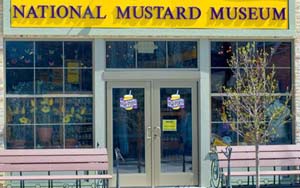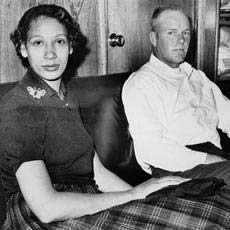|
 Welcome to the National Mustard Museum in Middleton, Wisconsin. |
(MUSIC)
I'm Faith Lapidus.
Today, we listen to music from Kenna.
And we answer a question about marriage between people of different races.
But, first we tell about some unusual museums in the United States.
(MUSIC)
Unusual Museums
FAITH LAPIDUS: Americans love museums. We have art museums, history museums, car museums, train museums and space museums. Many are famous. Millions of people from around the world visit them each year. And then we have those other museums. The kind that make you ask, "Did they really build a museum for that?" Mario Ritter tells us about some of these unusual museums.
MARIO RITTER: It may be yellow, brown, grey, mild, or hot and spicy. We put it on sandwiches, squirt it on hot dogs and even dip pretzels in it. No American picnic would be complete without mustard.
People in the town of Middleton, Wisconsin love it so much, they built a museum in its honor. The National Mustard Museum has over 5,000 kinds of mustard from 60 countries. You can even have a taste and buy containers of mustard in the museum.
If you visit the Banana Museum in Auburn, Washington you could learn everything you ever wanted to know about bananas. There are almost 4,000 objects in honor of this favorite fruit.
Another unusual museum is in Independence, Missouri. It has over 150 wreaths and 2,000 pieces of jewelry made with human hair. Leila Cohoon owns the museum and says some of the objects are over 100 years old. The human hair wreaths were considered pieces of art long ago.
If you are ever in Haines, Alaska you might want to visit the Hammer Museum. There you will find over 1,500 different kinds of hammers. Dave Pahl started the museum in 2002. He says some of the hammers on display were used thousands of years ago by the ancient Egyptians.
And then there is the Twine Ball Museum in Darwin, Minnesota. It has only one object on display – what it calls the largest twine ball in the world. A man named Francis Johnson began winding twine, or thick string, into a ball in March of 1950. He wound for four hours a day for 23 weeks. The ball got so big, he needed a crane to lift it so he could wind some more. Mr. Johnson wound the ball for about 30 years. When he was finished, the twine ball was four meters across and weighed 7,900 kilograms.
Or you could visit Barney Smith's Toilet Seat Museum in San Antonio, Texas. Yes, it is what you think it is! Mr. Smith says he has painted or decorated about 1,000 toilet seats. Many of the seats have personal meaning to him. Some show his travels around the world.
Then there is the Museum of Sex in New York City. That museum has ...sorry, we are out of time!
(MUSIC)
Interracial Marriages
FAITH LAPIDUS: Our listener question this week comes from Nigeria. David Odoviano wants to know about the history of interracial marriages in the United States, especially those between blacks and whites.
Marriages between people of different races were extremely rare in early American history. The first one on record took place in the state of Virginia in 1614. A white tobacco farmer named John Rolfe married the famous Indian Pocahontas.
Interracial marriages were illegal in many states. Miscegenation laws made it a crime for people of different races to marry. The state of Maryland passed the first miscegenation law in the early 1660s.
Charles Robinson is with the University of Arkansas, Fayetteville. He is vice provost for diversity, director of African-American studies and a history professor. He has done extensive studies on interracial relationships and miscegenation laws.
Professor Robinson says the Maryland law carried a severe punishment for white women who married black slaves.
CHARLES ROBINSON: "It punished them by making them servants to the master of the slave man for the length of that man's life."
FAITH LAPIDUS: Professor Robinson says it is not clear when the first marriage between a black person and a white person took place. But he says it appears to have been sometime in the 1660s.
CHARLES ROBINSON: "It's pretty obvious that blacks and whites had married by 1664 in Maryland because that law was instituted as a reaction to white women marrying slave men. But no one knows actually who was the first person or people to do it."
FAITH LAPIDUS: At least 30 states had miscegenation laws at one time or another. Many of the laws remained in force until 1967. That was when the United States Supreme Court ruled the laws unconstitutional in the miscegenation case of Loving vs. the state of Virginia.
|
 Richard P. Loving and his wife, Mildred in 1965. They won a US Supreme Court decision in 1967 that overturned laws prohibiting interracial unions |
Since the ruling in 1967, the number of interracial marriages has been steadily increasing. In the 1960s and 70s, interracial marriages were fewer than one percent of all marriages in the United States.
In June, the Pew Research Center released a new report based on information from the United States Census Bureau. It said more than 14 percent of all new marriages in 2008 were between people of different races or ethnic groups. This is more than double the rate in 1980.
(MUSIC)
Kenna
FAITH LAPIDUS: The music of Kenna is very hard to define. He calls it experimental. Author Malcolm Gladwell wrote about Kenna in his 2005 book "Blink." Bob Doughty has more.
(MUSIC)
BOB DOUGHTY: That was "Hell Bent," the first single from Kenna's 2003 album "New Sacred Cow." It was his first album release. The album included everything from hip-hop, to rock, to pop to electronica.
Kenna Zemedkun was born in Addis Ababa, Ethiopia. He moved to Cincinnati, Ohio with his family when he was three years old. But he spent most of his childhood in Virginia Beach, Virginia. He became interested in music after hearing "The Joshua Tree" album from the rock band U2. He began to teach himself to play the piano.
|
 Kenna |
(MUSIC)
In January, the musician climbed to the top of Mount Kilimanjaro, the highest mountain in Africa. He did it to bring attention to the worldwide clean water crisis. He took a team of scientists, activists and celebrities with him. This was Kenna's second attempt to reach the top. It was the largest group ever to complete the climb.
Kenna will release a new album later this year called "Songs for Flight." Until then, we leave you with "Baptized in Blacklight."
(MUSIC)
FAITH LAPIDUS: I'm Faith Lapidus. Our program was written by June Simms and Jim Tedder. Dana Demange was the producer.
You can get transcripts, MP3s and podcasts of our shows at voaspecialenglish.com. Join us again next week for AMERICAN MOSAIC, VOA's radio magazine in Special English.
pretzel: a crisp salty biscuit in the shape of a knot or stick, often served with drinks at a party(椒盐卷饼)
miscegenation: the fact of children being produced by parents who are of different races, especially when one parent is white (尤指白人和非白人)混种生育子女,混种
provost: (in the US) a senior member of the administrative staff at some universities(美国某些大学的)教务长
On television: a preview of the Primetime Emmys
A forest of art that grows on museum visitors in New York
An art exhibit wants visitors to be mindful of senses not everyone shares
A new public art project is bringing color and life to Washington D.C.
(来源:VOA 编辑:陈丹妮)
